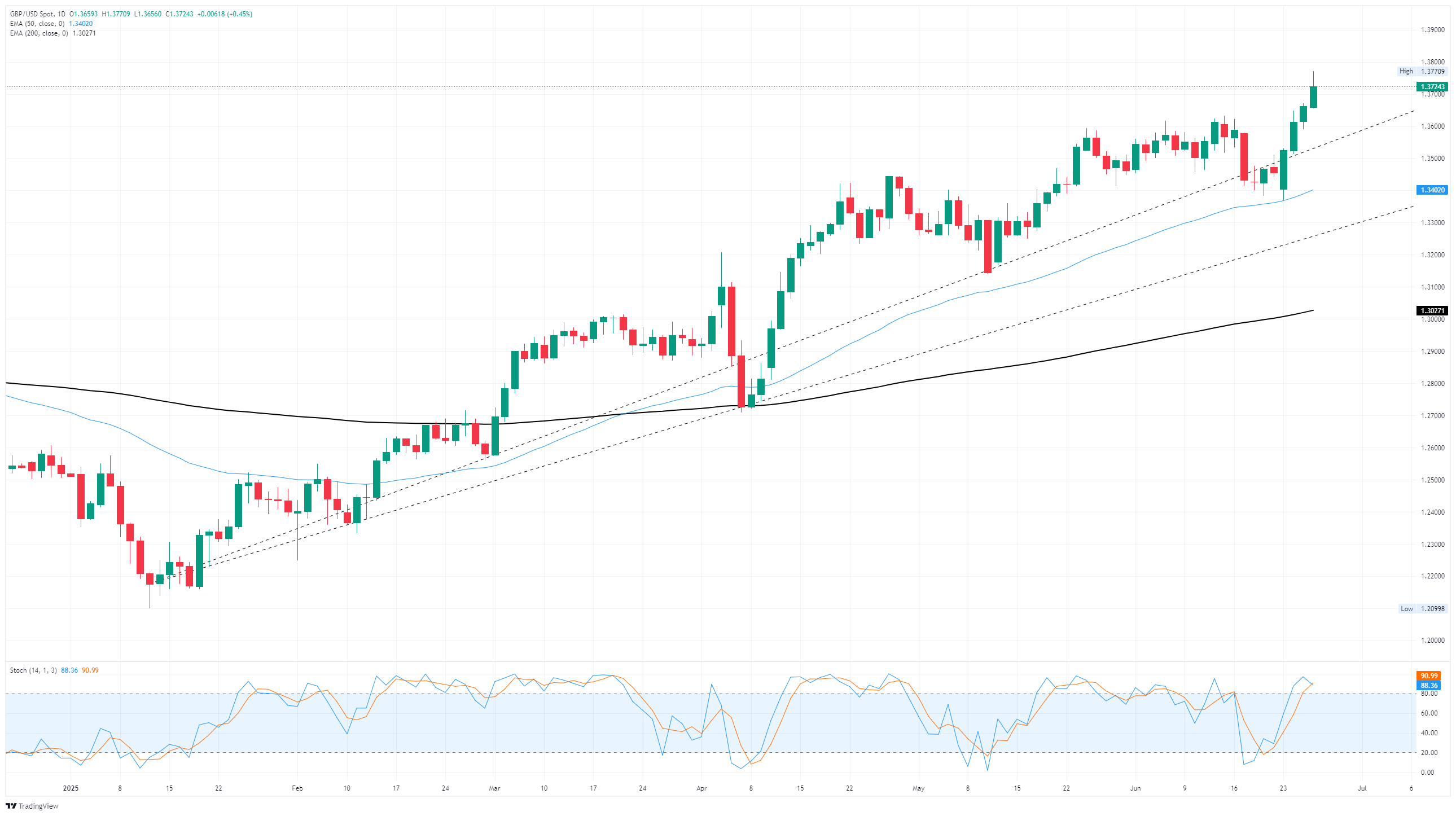GBP/USD continues its march up the charts for a fourth straight day
- GBP/USD gained ground on Thursday, tapping a new 44-month high.
- The Pound Sterling is getting firm support from a broadly weakening Greenback.
- US PCE inflation data to dominate the release calendar on Friday.
GBP/USD rose on Thursday, stepping into a fourth straight day of firm gains and clipping 44-month highs near 1.3770. A broad sell-off in the US Dollar is bolstering the Greenback’s major counter-currencies, helping to push Cable into its highest bids in nearly four years.
Market sentiment has recovered its footing following a tense start to the week: easing Middle East tensions and continued waffling on trade barriers by the Trump administration are helping to keep risk appetite on the high end. White House Press Secretary Karoline Leavitt floated the idea of the July 9 deadline for the return of reciprocal tariffs to not be a hard barrier, signaling to markets that the Trump administration has been pushed off of its high-tariff threats, even though prospects for the firm trade deals that President Trump was promising remain fairly anemic.
Inflation metrics will take on an increasingly significant role in the weeks and months ahead as policymakers and market participants alike look for signs of inflationary pressure from President Trump’s tariff policies. US Personal Consumption Expenditure Price Index (PCE) inflation for the month of May will print on Friday. Core annualized PCE inflation is expected to rise to 2.6% YoY, with monthly figures expected to hold steady at 0.1% MoM.
GBP/USD price forecast
GBP/USD caught an extended ride into fresh 44-month highs on Thursday, testing above 1.3770 for the first time since October of 2021. The pair is on pace to close in the green for a fifth straight month as the US Dollar broadly weakens across the board.
Cable bidders may be flying too close to the sun as GBP/USD price quickly outrun rising trendlines, with price action trading well above the 200-day Exponential Moving Average (EMA) near 1.3020. Technical oscillators are pinned in overbought territory, warning of a potential pullback on the cards.
GBP/USD daily chart

Pound Sterling FAQs
The Pound Sterling (GBP) is the oldest currency in the world (886 AD) and the official currency of the United Kingdom. It is the fourth most traded unit for foreign exchange (FX) in the world, accounting for 12% of all transactions, averaging $630 billion a day, according to 2022 data. Its key trading pairs are GBP/USD, also known as ‘Cable’, which accounts for 11% of FX, GBP/JPY, or the ‘Dragon’ as it is known by traders (3%), and EUR/GBP (2%). The Pound Sterling is issued by the Bank of England (BoE).
The single most important factor influencing the value of the Pound Sterling is monetary policy decided by the Bank of England. The BoE bases its decisions on whether it has achieved its primary goal of “price stability” – a steady inflation rate of around 2%. Its primary tool for achieving this is the adjustment of interest rates. When inflation is too high, the BoE will try to rein it in by raising interest rates, making it more expensive for people and businesses to access credit. This is generally positive for GBP, as higher interest rates make the UK a more attractive place for global investors to park their money. When inflation falls too low it is a sign economic growth is slowing. In this scenario, the BoE will consider lowering interest rates to cheapen credit so businesses will borrow more to invest in growth-generating projects.
Data releases gauge the health of the economy and can impact the value of the Pound Sterling. Indicators such as GDP, Manufacturing and Services PMIs, and employment can all influence the direction of the GBP. A strong economy is good for Sterling. Not only does it attract more foreign investment but it may encourage the BoE to put up interest rates, which will directly strengthen GBP. Otherwise, if economic data is weak, the Pound Sterling is likely to fall.
Another significant data release for the Pound Sterling is the Trade Balance. This indicator measures the difference between what a country earns from its exports and what it spends on imports over a given period. If a country produces highly sought-after exports, its currency will benefit purely from the extra demand created from foreign buyers seeking to purchase these goods. Therefore, a positive net Trade Balance strengthens a currency and vice versa for a negative balance.

